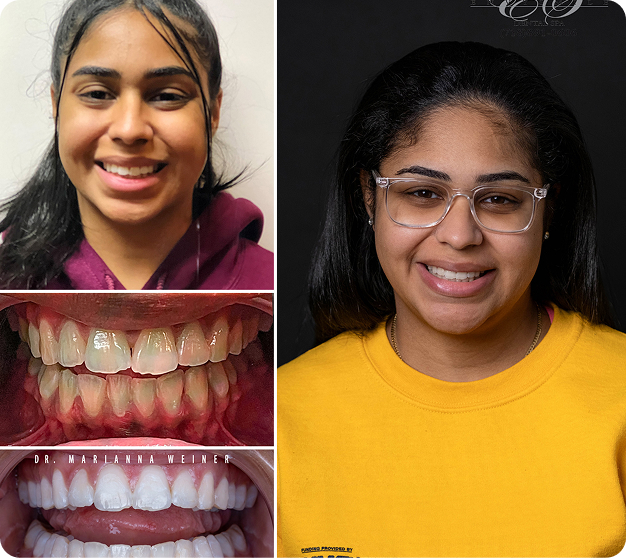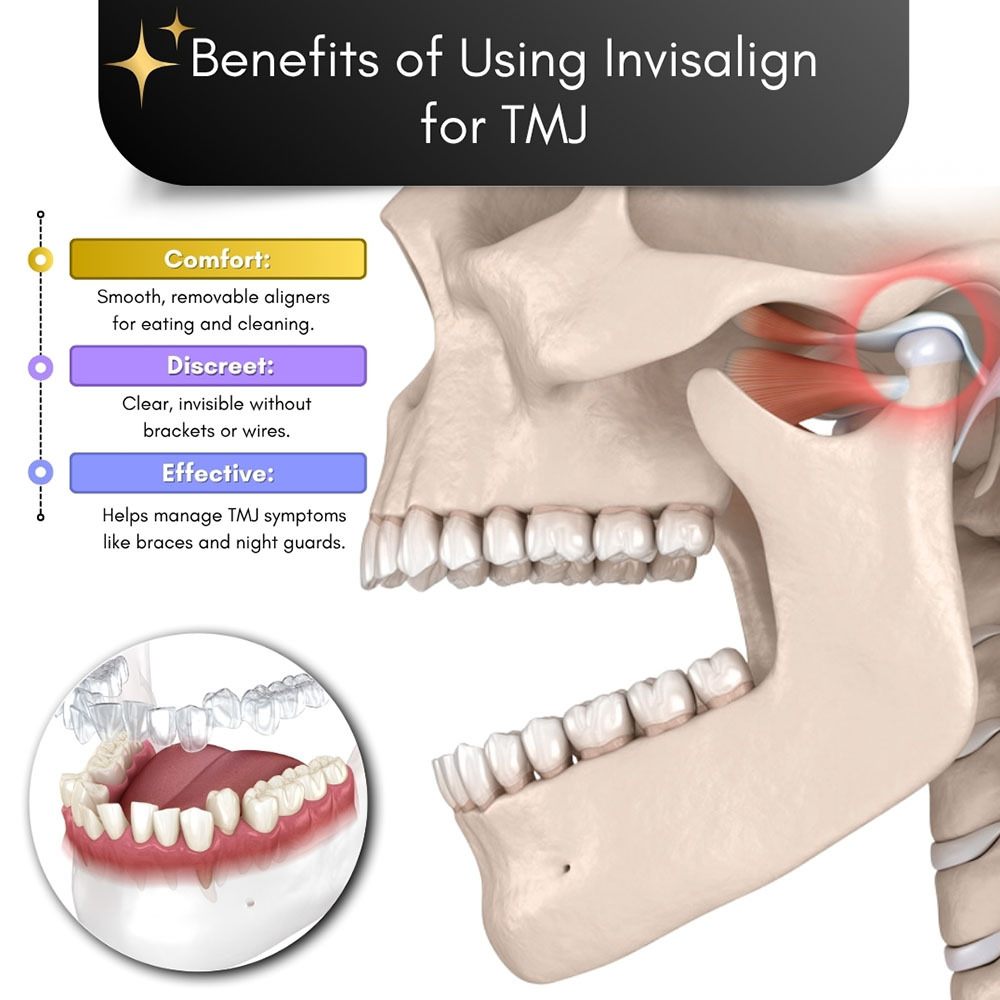What Is Invisalign?
Invisalign is an orthodontic system using removable, clear, plastic aligners to correct a wide range of problems affecting how teeth are positioned in the jaws. These include bite or occlusal problems, as well as issues with overcrowding and spacing.
What Is TMJ?
Generally, when your jaw joints are working properly, they operate smoothly and are pain-free. Most of the time, you are unaware that you are using them. In contrast, TMJ can be a painful condition. It occurs when the jaw joints that hinge your lower jaw to your skull and the muscles and ligaments operating these joints become inflamed.
The pain and discomfort caused by TMJ can make it tricky to eat, speak, and even sleep comfortably. It can also cause chronic headaches, tinnitus, and facial pain that extends into your neck and shoulders.
What Are the Symptoms of TMJ?
Symptoms of TMJ can vary and may include the following.
- Jaw and facial pain.
- Difficulty opening your mouth.
- Your jaw may make a popping or clicking sound when you open it.
- Migraines or headaches.
- Earache.
- Tinnitus.
- Toothache.
- Changes to the way your teeth fit together.
What Can Cause TMJ Dysfunction?
TMJ may be due to one problem, but a combination of factors often causes it. Potential causes can include the following.
- Teeth grinding and clenching (bruxism).
- Malocclusion is caused when your teeth don’t occlude or bite together properly.
- Stress which can cause problems like bruxism.
- Arthritis in your jaw joints.
- Injury to your jaw, for example, if it becomes dislocated or broken.
Some other factors or habits can worsen TMJ. These are outlined below.
- Using your teeth as tools, for example, when opening packets.
- Chewing on pens or pencils or chewing on ice cubes.
- Poor posture can stress your neck, shoulder, and facial muscles.
- Overworking your jaw muscles by chewing gum or even taking too large bites of food.
- Sleeping on your stomach.

How Can TMJ Affect Oral Health?
Not surprisingly, TMJ can make your life feel miserable. In addition to all the pain caused by inflamed jaw joints or chronic headaches, TMJ can affect your teeth.
A misaligned jaw can cause excess wear and tear on your teeth, especially if it causes bruxism. Consequently, your teeth may begin to chip or wear down, and you may notice other symptoms, such as increased tooth sensitivity or tooth pain.
If you or someone close has TMJ, Invisalign therapy could help you manage it more successfully. If your pain suddenly worsen, see our emergency orthodontist in Brooklyn promptly.
How Invisalign Works for TMJ
Invisalign aligners are custom-designed to treat problems like malocclusion using clear plastic aligners to move teeth into the proper positions gradually. Malocclusion issues that can result in TMJ can include:
- Overcrowded teeth.
- Spacing issues.
- Open bite.
- Crossbite.
- Underbite.
- Crooked teeth.
- Overbite.
If you have these problems, Invisalign might be suitable for you. Over time, your bite is realigned, so your teeth will meet properly.
Correcting malocclusion problems can help relieve many of the painful TMJ symptoms. When your teeth occlude or bite together properly, it doesn’t place your jaw joints, facial muscles, and ligaments under stress.
The aligners must be worn almost all the time, so you sleep in them, too. When TMJ causes bruxism, this can be a huge bonus. As your teeth become better aligned, you’ll notice a reduction in jaw joint pain and headaches, and the aligners prevent further wear and tear on your teeth.
As treatment progresses, the aligners will help retrain the muscles, causing you to clench and grind your teeth and act as night guards. Gradually, you should stop clenching and grinding as the aligners help break the habit.
What Our Patients Are Saying
Benefits of Using Invisalign for TMJ
If you have TMJ symptoms that are treatable with Invisalign, there are some benefits to using this system.
- Comfort and convenience. The aligners are made from smooth plastic, making them relatively comfortable to wear. Living with Invisalign is convenient because you remove the aligners for eating and oral hygiene.
- Aesthetic advantages. Once in your mouth, the clear plastic aligners are virtually invisible. You don’t need to worry that there will be any brackets or wires, so treatment is very discreet.
- Effective. Invisalign has a good track record in helping to manage TMJ symptoms when used appropriately. It can provide results comparable with other treatments like traditional braces and night guards for bruxism.

Comparison of Invisalign and Other Orthodontic Appliances
- Invisalign vs Breezy Braces
- Invisalign vs SureSmile
- Invisalign vs Clear Braces
- Invisalign vs Traditional Braces
Treatment Process for Invisalign
Treating your TMJ with Invisalign is straightforward, beginning with a consultation with our Invisalign dentist.
Consultation
A dental exam and discussion of your symptoms will determine if Invisalign is the right choice and can help relieve your TMJ symptoms.
Diagnostics
The next stage is a 3-D scan of your mouth, a quick and painless procedure that creates a 3-D digital model of your teeth. We may also wish to take other diagnostic tests to assess any damage to your jaw joints and to check for signs of other problems like arthritis or significant inflammation in these joints.
If you’ve previously worn a mouth palate expander, this will be considered during your assessment to ensure your Invisalign treatment plan is appropriately tailored, but it can increase the cost of the treatment process.
Custom Treatment Plan
Your custom treatment plan is based on this diagnostic information and uses Invisalign’s software. The plan will gradually correct malocclusion problems using a series of clear plastic aligners that force your teeth into the right positions.
You can view digital images of your treatment plan, showing how your bite will look once your teeth are straightened. Our orthodontist at Brooklyn Invisalign Center will also carefully explain how correcting these problems will help your TMJ.
Wearing Your Aligners
Once your aligners are created, we show you how to insert and remove them and discuss how to keep them clean. It is simply a matter of following your treatment plan, changing your aligners every two weeks, and seeing us regularly for checkups.
“ Since I met them my life become more confident ✨they are really one of the best professionals in brooklyn.100% recommended for Invisalign eligners. “

Guga Tsomaia Invisalign Patient
Related Articles
Taking the First Steps Toward Relieving Your TMJ Symptoms
If you have problems with your jaw joints or any questions about Invisalign, contact Brooklyn Invisalign Center to schedule an appointment with our orthodontist Dr. Simons. She can assess if Invisalign can help. In many cases, it is a good treatment for TMJ and can help you manage the symptoms without using braces.

